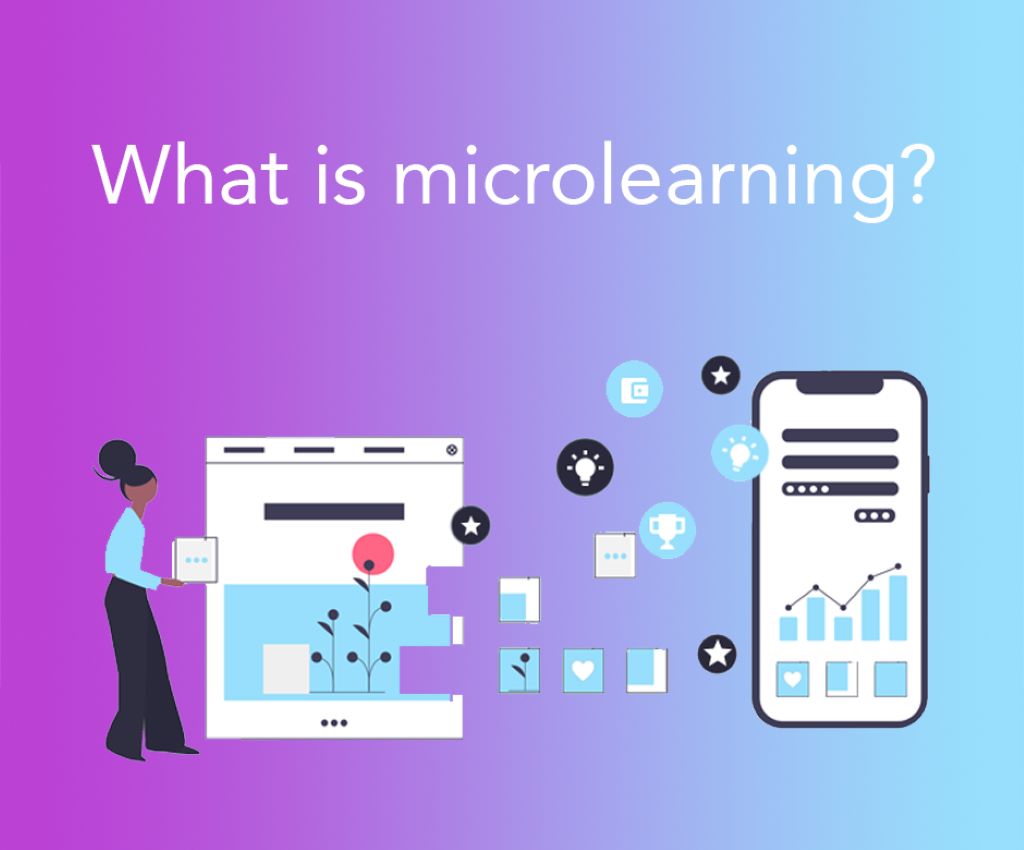Imagine traditional learning as a big, juicy steak dinner. It’s got all the elements for a satisfying meal, but sometimes it takes some time and might even feel overwhelming. Microlearning, on the other hand, is more like a series of tasty snacks spread throughout the day. It’s all about short, focused on what is microlearning and why care about it.
Think of it this way: Instead of a huge training manual, microlearning delivers information in quick doses, like a 5-minute video, an interactive infographic, or a short quiz. Microlearning is designed to fit into those little pockets of free time and tackle specific learning needs.
Why Is Microlearning a Big Deal?

Several reasons make microlearning a compelling strategy for individuals and organizations. Here’s why you should start paying attention:
- Our Shrinking Attention Spans: In today’s world of constant distractions, our attention spans seem to be getting shorter – some would say rivaling a goldfish! Microlearning, with its bite-sized bits of information, matches how our brains are wired to learn in this fast-paced era.
- The Need for ‘Just-in-Time’ Learning: Let’s be honest, when we need to solve a problem at work or learn a new skill, we usually don’t have the time or mental space to embark on a full-scale course. Microlearning offers us knowledge nuggets “just in time”—meaning you find the exact information you need right when you need it.
- Improved Knowledge Retention: Microlearning’s smaller chunks of information are easier to absorb and remember compared to those marathon training sessions. Also, when you revisit focused bits of knowledge over time (a process called spaced repetition), it actually helps them stick in your memory long-term. Think of it like watering a plant; small amounts of water often are better than drowning it all at once.
- The Power of Flexibility: Microlearning caters to the way schedules operate today. These small bursts of knowledge can be devoured during a short break, a train ride, or while waiting for an appointment. You control the pace of your learning.
What Does Microlearning Look Like in the Real World?
The beauty of microlearning is that it can take many forms! Here are just a few examples:
- Short Videos: Short video lessons provide digestible explanations of concepts or demonstrate procedures. They’re like visual cliff notes!
- Interactive Quizzes and Games: Engaging quizzes let you test your knowledge and make the learning process feel more like play than work.
- Infographics: Well-designed infographics present complex information in a visual format, making it easier to comprehend and remember.
- Podcasts or Audio Clips: Perfect for when you want to learn something hands-free. Throw them on while doing chores or your commute.
- Simulations: Safe, virtual environments to practice skills and apply knowledge in realistic scenarios.
Why Your Business Should Consider Microlearning
Now, if you’re in charge of training at your company (or you want to persuade those who are!), microlearning presents some huge benefits for organizations:
- Increased Engagement: When training is broken down into smaller, more palatable chunks, employees are less likely to feel overwhelmed and more likely to be engaged with the content.
- Better Performance and Productivity Just-in-time access to microlearning modules provides support right when employees need it. This on-the-job assistance promotes higher performance and a smoother workflow.
- Scalability and Efficient Updates It’s much easier to update or adjust a short and focused piece of content than it is an entire sprawling training program. This makes microlearning a scalable and responsive training strategy.
- Cost-Effective Development: Building a microlearning module or a set of videos typically involves less time and resources than full-fledged training programs.
Does Microlearning Replace Traditional Learning Entirely?
Not necessarily! Microlearning and traditional training methods coexist, each serving different purposes. Think of them as tools in your toolbox. For a foundational subject requiring deep conceptual understanding, a well-structured course could still be necessary. But, for reinforcing learned concepts, skill updates, or addressing specific pain points, microlearning truly shines.

When Microlearning Works Best
Microlearning excels in these situations:
- Performance Support: Need help with a particular task or navigating a software program? Short microlearning modules are a lifesaver while your employee is in the thick of things, saving time and reducing reliance on constant calls for help.
- Reinforcing Training: Supplement longer training sessions with microlearning bursts designed to refresh knowledge and ensure key concepts stay strong in your employees’ memories.
- Rolling Out Updates: Got changes to policies, products, or procedures? Bite-sized microlearning modules provide those updated bits directly and with minimum disruption to workflow.
- Upskilling and Reskilling: Microlearning’s focused nature is ideal for helping employees quickly add new skills and stay up-to-date with current trends and technologies.
How to Make Your Microlearning Truly Shine
Of course, not all microlearning is created equal. To get the most out of this approach, keep these tips in mind:
- Laser Focus: Each microlearning piece should target a single, specific learning objective. Resist the urge to cram too much in!
- Quality Matters: While microlearning may be shorter, don’t compromise on quality. It should be well-designed, engaging, and relevant.
- Variety is Key: Mix up your microlearning formats (videos, simulations, quizzes, etc.) to keep things exciting and cater to different learning preferences.
- The Learning Journey: Plan how individual microlearning units work together to build a larger learning path or to supplement existing training programs.
FAQs
How long should a microlearning asset be?
There’s no golden rule, but generally, it’s best to stick to around 3-7 minutes. Think snackable, not a feast.
Are there any drawbacks to microlearning?
The major pitfall is failing to see the bigger picture. You’ll still need a well-defined learning strategy, and some traditional training might be necessary for more in-depth subjects.
Can microlearning be used for any subject?
While fantastic for skill-based or targeted knowledge, it may be less effective for complex subjects demanding a deep conceptual foundation.
How do I measure the success of microlearning?
Focus on metrics like employee engagement, course completion rates, knowledge retention, and performance improvement where the training was applied.
How expensive is it to create microlearning content?
Compared to lengthy, comprehensive courses, you’ll generally save some costs. You can even repurpose some existing materials and keep production simple, particularly with videos and infographics.
Conclusion
Microlearning is a powerful tool for today’s fast-paced, knowledge-driven environment. By embracing the concept of small, focused, and flexible learning chunks, individuals and organizations can succeed with online learning, driving higher engagement, better knowledge retention, and overall improved performance.
If you’ve been tempted to write off learning and training as too time-consuming, microlearning provides a gateway that breaks those barriers. Why not experiment and see if this energizing approach is right for you and the challenges you face?







